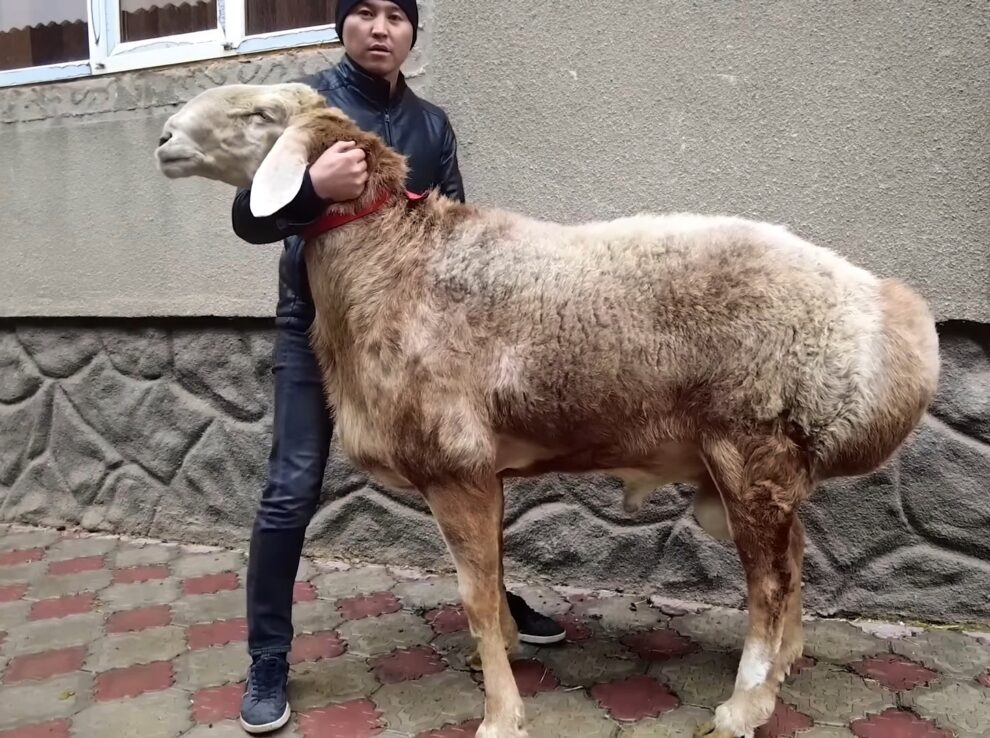DUSHANBE, 11/07/2023 /NIAT “Khovar”/. Livestock farming is one of the most important sectors of the agricultural sector in Tajikistan, which plays an important role in ensuring the country’s food security. According to statistics, as of October 1 of this year, in all forms of management of the republic there are 2 million 626 thousand 973 heads of cattle, 6 million 622 thousand 422 heads of sheep and goats and 87 thousand horses, during this period 202187.8 tons were produced meat. NIAT “Khovar” was informed about this by the Ministry of Agriculture of the Republic.
One of the types of livestock raised in the Republic of Tajikistan and known in the world is the Gissar sheep, considered the largest in the world. The Gissar breed sheep is purely Tajik, the history of its origin goes back to ancient periods. The Gissar sheep is a local wire-haired sheep breed with a huge tail. This breed of sheep was raised for meat and fat tail, bred in the Gissar Valley. The main population of Gissar sheep exists in Tajikistan, they are mainly raised in the Gissar Valley and Khatlon region.
As Safarali Nabotov, head of the department of selection and technology of sheep and goat breeding of the Institute of Animal Husbandry and Pastures of the Academy of Agricultural Sciences of Tajikistan, noted during a conversation with a correspondent of NIAT “Khovar”, the role of Gissar breed sheep in improving the productivity of the sheep breed with a huge tail and creating new breeds in the republics of Central Asia and Kazakhstan is very large. Using sheep of the Hissar breed in Tajikistan, breeds of Tajik meat and fat-tailed sheep with thick wool were bred, in Kazakhstan – fat-tailed “Ordabasin”, semi-fine-fleeced “Aktobe” breeds, in Uzbekistan – meat and fat-tailed “Ustyurt” breeds of sheep with thick wool, also fat-tailed breeds “Kelesi” and “Andijani”. Breeding work continues.
The Gissar sheep breed got its name from the region where they were raised, that is, the Gissar Valley of Tajikistan. Back in 1298, the famous traveler Marco Polo got acquainted with the breed of Hissar sheep in this area and wrote down his opinion about these sheep in his book: “Sheep are the size of a donkey, their tails are thick, large, sometimes weighing thirty pounds. Nice, fat sheep, tasty meat.”
Safarali Nabotov notes that in the direction of improving the hereditary and productive nature of the Gissar breed of sheep, scientists from the department of selection and sheep breeding technologies of the Tajik Research Institute of Animal Husbandry, created in 1931, as the first scientific and experimental station of the republic for animal husbandry, began scientific selection work, which continues to this day.
Currently, the population of Gissar sheep in Tajikistan is more than 1.7 million heads; 7 breeding plants and farms are engaged in their breeding in Tajikistan.
“Due to the largest live weight in the world, the area for growing and breeding sheep of the Gissar breed is not limited only to Tajikistan. In different years, sheep of the Gissar breed are transported from the Republic of Tajikistan to the republics of Uzbekistan, Kazakhstan, Kyrgyzstan, as well as to the Russian Federation, Ukraine and Belarus, where they are bred,” the interlocutor notes.
Currently, the best sheep of the Gissar breed are raised at the Khisor factories in the Farkhor district, the Zotparvar state unitary enterprise in the Gissar and Shakhrinav districts, in the Somonjon production cooperative in the Dangara region, in the Dilshod-B production cooperative in the Varzob region and other farms. These farms play an important role in the cultivation and growth of highly productive sheep.
It should be noted that as a result of many years of scientific research by scientists from the department of selection and technology of sheep breeding of the Institute of Livestock and Pastures of the Academy of Agricultural Sciences of Tajikistan, in collaboration with farmers from the Gissar breeding enterprise of the Farkhor region, the “Farkhori” type of this breed was created.
Currently, in two breeding farms of the Republic of Tajikistan, scientists from the Department of Breeding and Technology of Sheep and Goat Breeding of the Institute of Livestock and Pastures of the Academy of Agricultural Sciences of the Republic of Tajikistan and specialists from breeding farms have completed scientific and breeding work to create a new factory type called “Shahrinavi”.
In 2022, the state approbation commission gave a positive assessment to this new type of sheep of the Hissar breed and submitted it to the Ministry of Agriculture of the Republic of Tajikistan for official state approval. On April 15 of this year, the “Shakhrinavi” type of sheep of the Gissar breed was officially approved by the decision of the board of the Ministry of Agriculture of the Republic of Tajikistan.
The breeding population of the created type is explained by the following productivity indicators: the live weight of newborn lambs is 5.5-7.5 kg, breeding lambs – 135-145 kg, in the best individuals – up to 175 kg, ewes – 85-90 kg, in the best individuals – up to 135 kg. Sheep of this type, along with their high living Yesom, also have wool productivity.
According to Safarali Nabotov, the scientific school of sheep breeders of Tajikistan in the region has been a leading guide in this important area since 1947. “Due to the long work of scientists and scientific research of the Republic of Tajikistan, more than 30 doctoral and candidate dissertations were defended. Increasing the number of Gissar sheep makes it possible to increase meat production in the republic and make a significant contribution to ensuring food security,” he added.
Source: Khovar TJ















